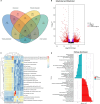Microbial survival strategies in desiccated roots of Myrothamnus flabellifolia
- PMID: 40226100
- PMCID: PMC11985526
- DOI: 10.3389/fmicb.2025.1560114
Microbial survival strategies in desiccated roots of Myrothamnus flabellifolia
Abstract
Introduction: Root-associated microbiomes are critical to plant vigor, particularly under drought stress. The spatial dynamics of microbial community diversity and composition are strongly influenced by plant root and environmental factors. While the desiccation tolerance of the resurrection plant Myrothamnus flabellifolia using leaf tissue has been previously investigated, the transcriptional responses of its root-associated microbiomes under desiccation remain completely unexplored.
Methods: Here, we conducted metatranscriptome sequencing on root samples of M. flabellifolia collected in the field across four states: dry, desiccated, partially hydrated, and fully hydrated.
Results: Bacterial transcripts dominated the root metatranscriptome across all conditions. Desiccated roots exhibited a significant increase in transcripts from Actinomycetota, whereas fully hydrated roots showed an enrichment of Pseudomonadota. Under desiccation, root-associated bacteria upregulated genes involved in antioxidant systems, trehalose biosynthesis, and hormonal regulation.
Discussion: These findings highlight microbial adaptive mechanisms to withstand extreme water loss. In contrast, the bacterial transcriptional response in hydrated roots was characterized by genes linked to peptidoglycan biosynthesis, sugar transporters, and chemotaxis. Taken together, our findings indicate that root-associated bacteria deploy defense mechanisms analogous to those of their host plant to adapt to extreme drought stress, highlighting their crucial role in plant resilience.
Keywords: Myrothamnus flabellifolia; desiccation; metatranscriptomics; microbiomes; plant growth-promoting bacteria; resurrection plants; rhizosphere.
Copyright © 2025 Tebele, Marks and Farrant.
Conflict of interest statement
The authors declare that the research was conducted in the absence of any commercial or financial relationships that could be construed as a potential conflict of interest.
Figures






References
-
- Asami P., Rupasinghe T., Moghaddam L., Njaci I., Roessner U., Mundree S., et al. . (2019). Roots of the resurrection plant Tripogon loliiformis survive desiccation without the activation of autophagy pathways by maintaining energy reserves. Front. Plant Sci. 10. doi: 10.3389/fpls.2019.00459 - DOI - PMC - PubMed
-
- Barrs H. D., Weatherley P. E. (1962). A re-examination of the relative turgidity technique for estimating water deficits in leaves. Aust J Biol Sci. 15, 413–428.
LinkOut - more resources
Full Text Sources

